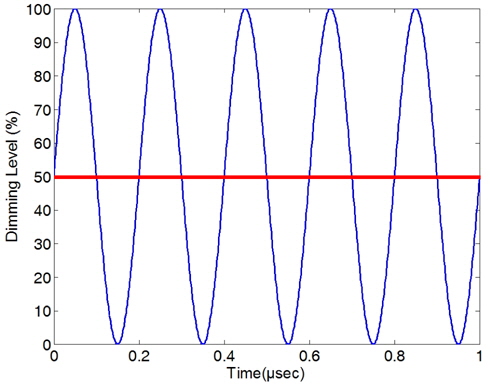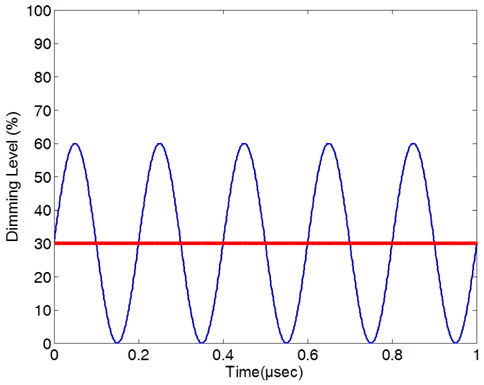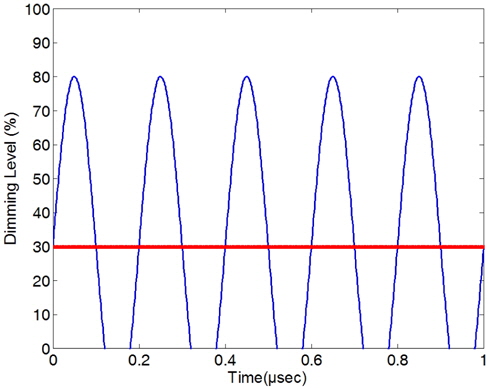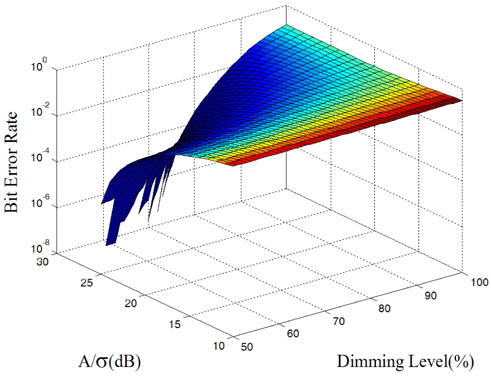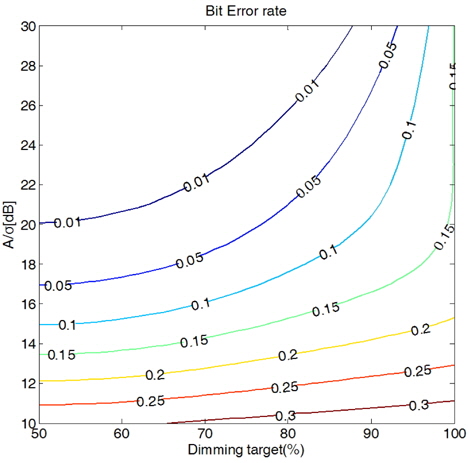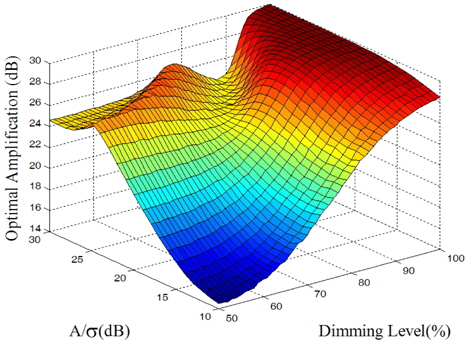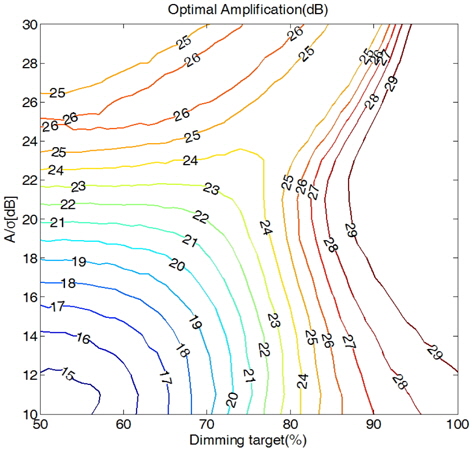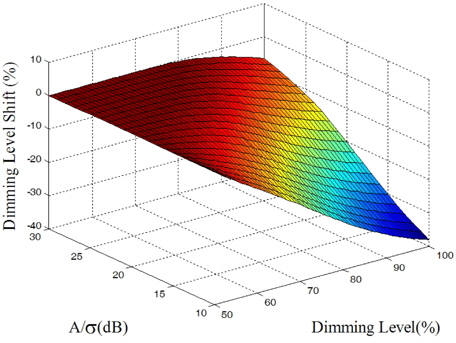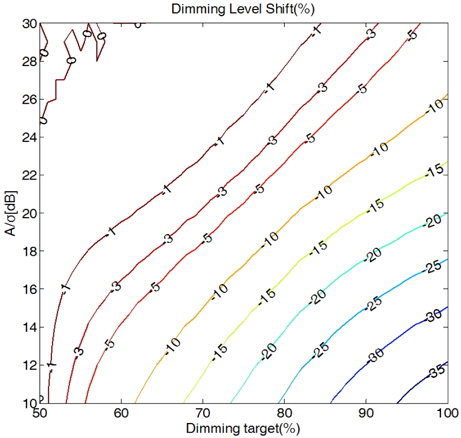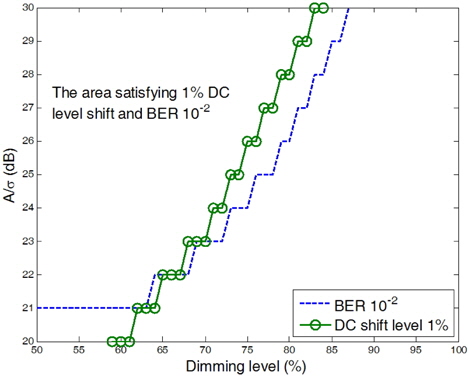



The demand for wireless data has increased considerably in recent years. As a new wireless medium, visible light communication (VLC) is a new candidate to convey data using light-emitting diodes (LEDs) [1-3]. The first standardization was completed by the 802.15.7 VLC Task Group [4]. VLC modulates data by blinking LEDs, which have rapid electrical responses. An electrical signal is converted to an opticalintensity signal via LEDs, which is known as intensity modulation (IM), and a noncoherent receiver, such as a photodetector (PD), restores the electrical signal proportionally to the received optical intensity, which is known as direct detection (DD). Considerable research has been conducted on VLC systems, such as implementation techniques [5-8], channel characteristics [9], multiple-input/multiple-output techniques [10, 11], orthogonal frequency-division multiplexing (OFDM) [12-19], and schemes for dimming requirements [19-43]. Dimming is a unique characteristic of VLC, which makes it different from conventional optical wireless communications (OWCs). The original lighting purpose of LEDs gives rise to the inherent constraint that the mean intensity matches the dimming requirements of the user. For ON-OFF keying (OOK) modulation, the ratio of the “ON” time to “OFF” time of the signal is adjusted in a transmission data frame to meet the dimming requirements, resulting in the design of a scheme maintaining the Hamming weights associated with the dimming requirement. Pulse-width modulation (PWM) is applied for dimming support [19-21], and can also be superposed with OOK and pulse-position modulation (PPM) [22, 23]. These schemes are simple, but they either produce marginal rate enhancement or are vulnerable to noise. Pulse-amplitude modulation (PAM) is used for VLC applications [24]. Analog dimming [25] adjusts the dc bias of the signal, such that the overall symbol levels meet the dimming targets. This is also simple, while incurring the cost of sophisticated intensity control and weakness to noise. Variable pulse-position modulation (VPPM) [26, 27] combines 2-PPM and PWM, which are responsible for communication and dimming, respectively. Pulse dual-slope modulation [28], which is a variant of VPPM, offers improved flicker mitigation. Multicoded VPPM [29] adopts cyclic
This paper reports OFDM systems in dimmable visible light communications. Section 2 reviews the basic characteristics for OFDM systems and dimming in VLC. Section 3 reports the simulation environments, and the best bit-error rate (BER) and the corresponding optimal amplification depending on channel quality and dimming are obtained. Section 4 reports the conclusions.
OFDM is called multiple-subcarrier modulation (MSM) [44] in OWC. Because the intensity of an OFDM signal can be negative, two different techniques for generating nonnegative symbols suitable for IM have been proposed: DC-biased optical OFDM (DCO-OFDM) [3] and asymmetrically- clipped optical OFDM (ACO-OFDM) [45]. This paper uses the more commonly assumed DCO-OFDM, where a DC bias is applied to yield a nonnegative signal. MSM, which is realized by OFDM, offers a simple way of mitigating the fading effects resulting from delay spread [44], whereas it has poorer power efficiency than single-carrier approaches. Logically, optical OFDM in Fig. 1 is similar to radio-frequency (RF) OFDM, except for dimming. On the other hand, there is a difference in the inverse fast Fourier transform (IFFT). The OFDM baseband signal is nonnegative and real, because of the intensity modulation by LEDs. Therefore the data symbols are Hermitian symmetric (
2.2. Dimming and Trade-off by Amplification
OFDM signals are bipolar with respect to the average, which is normally zero. Because VLC offers only nonnegativity, the average should be moved to a positive value. This average value becomes the required dimming level of the lighting. Clipping is inevitable in OFDM, and it is more severe when the dimming target is very low (near zero) or high (near the maximum intensity), because the signals should be within [0,
The channel quality of VLC under additive Gaussian noise with the standard deviation, σ, is expressed as the maximum-intensity-to-noise ratio (
3.1. Simulation Environments
The simulation parameters are given in Table 1. At a transmitter, a series of random data is generated and trans formed to an OFDM signal by IFFT. The amplification and shift for dimming are applied, followed by clipping. Clipping prevents overheating, to avoid either degradation of the output light or total failure [46]. The channel quality
[TABLE 1.] Simulation parameters
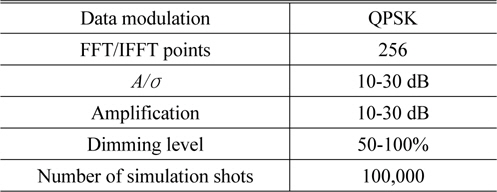
Simulation parameters
Figure 7 shows the best BER obtained for a given channel quality and dimming. The BER changes depending on the amplification, and the best BER and the corresponding optimal amplification are obtained after an exhaustive search. For a given
Figure 9 shows the optimal amplification for Fig. 7, and Fig. 10 presents the contour representation of Fig. 9. For 50% dimming, the channel quality and optimal amplification increase linearly when the channel quality is less than 25 dB, where the effects of noise and clipping are balanced. For high channel quality, noise becomes negligible. Therefore, reduced clipping results in no further amplification. High-end clipping always occurs for approximately 100% dimming. Because more amplification toward a lower direction reduces the effects of noise, the optimal amplification increases. Note that the simulation is performed for an amplification of 10-30 dB.
In addition, uneven clipping yields a change in the average of the signals, and a shift in dimming follows. This is a critical problem for user demand of the requested dimming level. More uneven clipping induces a further shift in the resulting dimming. Figure 11 shows the resulting shifts, and Fig. 12 shows the contour representation of Fig. 11. A smaller
Figure 13 shows the region where the BER is less than 10-2 and the shift in dimming is less than 1%. OFDM is not a suitable option with
This paper reports the optimal amplification and BER depending on the channel quality and dimming target in VLC OFDM systems. In addition, a shift in the resulting dimming caused by uneven clipping is observed. With the restrictions of 10-2 BER and a 1% dimming shift, OFDM is not preferable with


